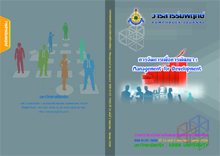ประสิทธิผลของการบริหารความเสี่ยงในการเคหะแห่งชาติ
Main Article Content
Abstract
วิเคราะห์ข้อมูลใช้แนวทางการวิจัยเชิงปริมาณเป็นหลัก และแนวการวิจัยเชิงคุณภาพเป็นการสังเคราะห์ข้อมูลสนับสนุน การวิเคราะห์ข้อมูลเชิงปริมาณใช้สถิติ Canonical Correlation ในการทดสอบสมมุติฐาน และใช้การวิเคราะห์เส้นทาง (Path Analysis) เป็นแนวทางการสร้างตัวแบบสุดท้าย
ผลการทดสอบสมมติฐานโดยการหาค่าสัมประสิทธิ์สหสัมพันธ์ Canonical พบว่า การบริหารความเสี่ยงของการเคหะแห่งชาติเฉพาะด้านการกำหนดวัตถุประสงค์มีความสัมพันธ์กับประสิทธิผลของการเคหะแห่งชาติเฉพาะด้านการดำเนินงานของ องค์การ อย่างมีนัยยะสำคัญ จากผลการศึกษาเบื้องต้นนำไปสู่การสร้างตัวแบบการบริหารความเสี่ยงของการเคหะแห่งชาติ กับประสิทธิผลของการเคหะแห่งชาติ โดยการวิเคราะห์เส้นทาง (Path Analysis) ทำให้เกิดองค์ความรู้ใหม่และแนวทางใน การกระตุ้นบทบาทการบริหารความเสี่ยงของการเคหะแห่งชาติ เป็นส่วนสำคัญที่ทำให้การบริหารความเสี่ยงของการเคหะแห่งชาติสามารถบรรลุการดำเนินการให้เกิดประสิทธิผลต่อการบริหารการเคหะแห่งชาติได้อย่างต่อเนื่องและยั่งยืน
Effectiveness in Risk Management of the National Housing Authority
The objectives of this research were: 1) to analyze the risk management of the National Housing Authority comprising of eight aspects i.e. risk prevention, objective determination, risk analysis, risk assessment, risk management activities, risk control, risk communication and risk monitoring ; 2) to analyze the effectiveness of the National Housing Authority comprising of five aspects i.e. organization strategic planning, organization operation, management capability of the leader, human resource management, and organizational performance inquiry; 3) to investigate the correlation between the risk management of the National Housing Authority and the effectiveness of the National Housing Authority. The population of this study were 2,594 employees from all levels of the National housing Authority. For this research, the analysis of data for quantitative research was used as the core study and synthetic data analysis under qualitative research was the supporter. As for the quantitative data analysis, the Canonical Correlation was used for the statistical analysis on hypothetical testing and Path analysis was used as the research model.
The results of the hypothetical testing through Canonical Correlation Coefficient revealed that the objective determination of risk management of the National Housing Authority was related to the organizational operation for effectiveness in risk management of National Housing authority at statistical significance.
In addition, the results of the research contributed to determine the new model of risk management of the National Housing authority through Path Analysis that created the new knowledge and an approach to stimulate the risk management at the National Housing Authority, especially in terms of organizational operation. It could be explained that it was necessary to impose good and explicit objectives for the organizational operation to achieve continuous and sustainable management at the National Housing Authority.
Article Details
Every article published in the Romphruek Journal of the Humanities and Social Sciences is the opinion and point of view of the authors. Thery're not the viewpoint of Krirk University or the editored department. Any part or all of the articles for pablication must be clearly cited.

